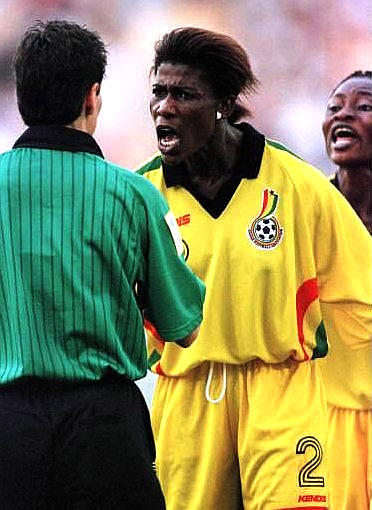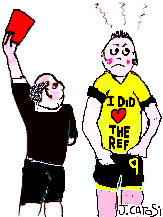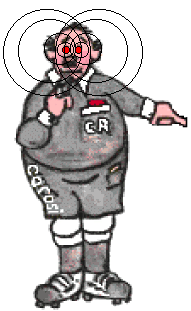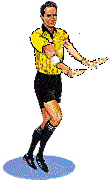| |
 |
DIFFUSING DISSENT
On the PITCH…
Andrew Castiglione
Founder of Ken Aston Referee Society
 |
Make Referees think about
ways they can diffuse dissent on the field of play.
It is important to note that the advice given here
is not necessarily the ‘official line’, but nevertheless, is
used by many Referees when controlling players.
Key phrases (‘one-liners’) and
tips that Referees can use and find work for
them in different
situations that can occur during a game when tying to...
Diffuse
Dissent.
The trick here is to keep your ’one-liners’ short, and
vary them when you can. Dissent is a difficult thing to control,
and the advice given here should help you think about ways that
you can use. Don’t try and remember, or use all of these tips in
one go. Use one or two new ones each game, vary them slightly to
suit your personality, and you will soon find that you have made
up your own ‘one-liners’ to suit each incident. The main aim of
the ‘one-liners’ is to diffuse the situation, to allow you to
give the perpetrator a ‘rollicking’ rather that caution them.
Albeit that you will sometimes need to show them a ‘yellow
card’. |
 |
‘One-liner’s will depend on the character of the Referee. You will need
to develop those methods that personally suit your personality. In other
words, you will need to be able to ’carry-off’ these methods without
looking as though they are choreographed.
For example, a very simple on-liner that I often use is
"Shut up!"
That’s it – BUT there is a method in applying this simple phrase. When
play is stopped, and you want to impart this strong message to a
dissenting player, move away to an empty part of the field of play at
least 15 yards away or more from the player you want to talk to. As you
are walking to this position, say out loudly
"Come here number 5" (or
whatever number he is!). Moving to this position will allow the player
to vent off some of his steam by the time he gets to you. Keep your eyes
downwards, and when he gets near to you, simply lift your head, make eye
contact and simply and quietly say to him
"Shut up!" and then
immediately walk away to your new position in readiness to restart play.
This gives a clear message to the player, and to all those watching. It
also allows the Referee to cool down himself and impart a strong message
of quiet confidence and control. This method is more suitable to those
Referees who have a strong bearing and a more dominant character. It
would not be any good (for instance) for a new Referee, or youth Referee
to try this method.
These tips are not exhaustive, and are here to give Referees some food
for thought. Referees are encouraged to use their own methods and
‘one-liners’. The Referee must always be polite and
NEVER swear or berate players.
One-liners and tips you can use (with a smile) without having to stop
play to talk to the perpetrator.
 - 1. "Not that old ‘chestnut’ again, can’t you think of
anything more original"?
- 1. "Not that old ‘chestnut’ again, can’t you think of
anything more original"?
(This is a good 'one-liner' to reply to the players' old favorite
comment such as "You must be joking Ref.!")
 - 2. A ‘stare’ is a very good tool when the player is
some distance away from you. This lets him know that you have
heard what he said, and that you are aware of him! Do this when
the ball is out of play, so that you don’t lose concentration on
the game. It works a treat, and you can do it even if the player
is at the other end of the field of play.
- 2. A ‘stare’ is a very good tool when the player is
some distance away from you. This lets him know that you have
heard what he said, and that you are aware of him! Do this when
the ball is out of play, so that you don’t lose concentration on
the game. It works a treat, and you can do it even if the player
is at the other end of the field of play.
If the player is not looking at you (this is because he knows
you have spotted him, and he is trying to avoid eye contact with
you) - his eyes will eventually meet yours – and no words are
needed. Stare at him for about 5 seconds. A slight shake of your
head from side to side will also strengthen your message to him.
 - 3. In addition to this, when you have engaged the
players’ eyes, another tip is to use body language. Use your
hand and mime the ‘zip your mouth’ movement. I.e. pretend that
you are zipping your mouth closed.
- 3. In addition to this, when you have engaged the
players’ eyes, another tip is to use body language. Use your
hand and mime the ‘zip your mouth’ movement. I.e. pretend that
you are zipping your mouth closed.
This is a very good way impart your views (without words) over
long (or even short) distances on the field of play. |
 |
 - 4. "If I wanted to have an afternoon of nagging, I would have
stayed at home".
- 4. "If I wanted to have an afternoon of nagging, I would have
stayed at home".
 - 5. "Stop moaning and get on with it."
- 5. "Stop moaning and get on with it."
 - 6. A wry smile as you run by, is also most disconcerting to a
player. This tells him that you have heard him, but think his comments
are childish.
- 6. A wry smile as you run by, is also most disconcerting to a
player. This tells him that you have heard him, but think his comments
are childish.
 - 7. Use one hand to ‘brush away the fly’. In other words, use
your arm and hand to wave away the dissent.
- 7. Use one hand to ‘brush away the fly’. In other words, use
your arm and hand to wave away the dissent.
 - 8. A simple shake of the head whilst looking at the player is
another simple method of putting the player ‘in his pace’.
- 8. A simple shake of the head whilst looking at the player is
another simple method of putting the player ‘in his pace’.
One-liners and tips you can use (with a smile) when play has stopped and
you wish to talk to the perpetrator.
As mentioned above, the trick is for Referees to accept that football is
a very emotive game, and passions will always run high. When dealing
with diffusing dissent when play is stopped, and when you want to impart
a warning message to a dissenting player, you must give that player a
moment or two to ‘cool down’. You can do this by moving away to an empty
part of the field of play at least 15 yards away or more from the player
you want to talk to.
As you are walking to this position, say out loudly
"Come here number 5" (or
whatever number he is!).
Moving to this position will allow the player to vent off some of his
steam by the time he gets to you. As the player approaches, if you
anticipate that he is approaching you in a manner that suggests that he
will take some stopping as he approaches you. Tell him to "calm down",
"slow down", "keep a distance away" or any other verbal warning that you
can think of to that effect. Do not put the whistle to your mouth
(unless you want to lose more teeth than is necessary under the
circumstances). At the same time, use your 'body language' by holding
out both of your hands palms forward (like shooing cows back) and
gesture at the player to slow down. Do not stand still at first when you
are doing this, else you are likely to get stampeded. Use a bit of Law
18 Common sense, and gain a few extra moments by moving backwards a few
more steps whilst making the warning actions just mentioned. Do not take
too many steps backwards, because there comes a moment when you have to
make a stand and show the approaching player that you are in charge and
will not be intimidated. When you reach this moment - 'stick to your
guns' - stand firm and erect, and then say your ‘one-liner’.
1. "I didn’t call you over here for you to give ME a
lecture".
2. "If you continue to disagree with my decisions, I
have no choice but to take action against you". It is important to
note – do not say " The next time that I have to speak to you, it will
be to caution you". This will put the Referee in a difficult position,
and will leave him with no leeway but to implement the caution the next
time he speaks to this player. Referees should never ‘set out their
stall’, by threatening cautions next time around!
3. One exception to the above, that I personally I use,
when I "really do mean that I will caution this player" the next time he
misbehaves: -
"The next time you so much as fart in the rest of the game, you will
be going in my book".
Once again, those Referee characters that can impart this strong, final
and somewhat humorous message should only use this line.
4. "I’m giving you a few moments to calm
down. Count to 10.
OK?…………………………. Then let’s get on with it".
Say the above line to
the player as he approaches you. This is a useful
line to diffuse an irate player. And one, which I use in every
game.
Put both your arms down in front of you at about 45 degrees,
with fingers pointing upwards palms facing the oncoming player.
This body action tells the player to calm down, and can be
clearly seen by anyone out of earshot. |
 |
5. "Are you OK? Calm down a bit. You should see your
face!"
This is a useful line to diffuse a player whose eyes are ‘bulging out on
stalks’. It usually ends in a smile from the player. I.e. you have
broken the spell of dissent. You can then ask him to behave himself.
How you deal with dissent around you rather than coming from one
particular individual.
 - 1. When you have given a free kick, move away swiftly to a
new position. Staying near the area of the free kick will invite
dissenting comments. Players will never (or very rarely) run after you,
if you’re quick enough. There will of course be occasions when you will
need to remain near the area of a free kick (ceremonial free kicks, and
when a player has been injured, or when you anticipate confrontation
between opposing players.
- 1. When you have given a free kick, move away swiftly to a
new position. Staying near the area of the free kick will invite
dissenting comments. Players will never (or very rarely) run after you,
if you’re quick enough. There will of course be occasions when you will
need to remain near the area of a free kick (ceremonial free kicks, and
when a player has been injured, or when you anticipate confrontation
between opposing players.
 - 2. When players (as a whole) are giving the Referee open
‘corporate’ dissent, the Referee can:
- 2. When players (as a whole) are giving the Referee open
‘corporate’ dissent, the Referee can:
 - (a) Shout out loud enough for everyone to hear: "Get
on with the football lads!"
- (a) Shout out loud enough for everyone to hear: "Get
on with the football lads!"
 - (b) Stop the game (or when play has naturally
stopped) call the both captains together, and say:
- (b) Stop the game (or when play has naturally
stopped) call the both captains together, and say:
"If your players continue with open dissent, I have no option but to
apply the letter of the Law"
 - (c) When open dissent is increasing, one tip is to stop play
for every foul, no matter how small. Do not allow ANY advantage until
the players have calmed down. Keep blowing your whistle until they get
the message. Peep, peep, and peep for every infringement. If you allow
advantage to flow during a tetchy game, it will undoubtedly cause you
much more trouble. Advantage is applied when a player has been fouled,
and play is allowed to continue because the fouled player (or his team)
gains more of an advantage by continuing play, rather that restarting
play with a free kick. When players are angry, or are openly showing
dissent, there is a great danger of further fouls and retribution
occurring if a Referee allows advantage to flow during these periods.
Once the players have settled down, the Referee can consider applying
advantage once again in the game.
- (c) When open dissent is increasing, one tip is to stop play
for every foul, no matter how small. Do not allow ANY advantage until
the players have calmed down. Keep blowing your whistle until they get
the message. Peep, peep, and peep for every infringement. If you allow
advantage to flow during a tetchy game, it will undoubtedly cause you
much more trouble. Advantage is applied when a player has been fouled,
and play is allowed to continue because the fouled player (or his team)
gains more of an advantage by continuing play, rather that restarting
play with a free kick. When players are angry, or are openly showing
dissent, there is a great danger of further fouls and retribution
occurring if a Referee allows advantage to flow during these periods.
Once the players have settled down, the Referee can consider applying
advantage once again in the game.
 - 3. Awarding Offside can invariably open up a tirade of
comments from players. A useful tip for Referees (when the Referee is
near the scene of the offside) is to blow the whistle long and very
loud. At the same time, move away from the scene of the offside. This
action has two effects. Firstly, the Referee cannot hear the dissent,
and secondly, neither can anyone else! This tip can also be used when
awarding free kicks.
- 3. Awarding Offside can invariably open up a tirade of
comments from players. A useful tip for Referees (when the Referee is
near the scene of the offside) is to blow the whistle long and very
loud. At the same time, move away from the scene of the offside. This
action has two effects. Firstly, the Referee cannot hear the dissent,
and secondly, neither can anyone else! This tip can also be used when
awarding free kicks.
Dealing and punishing dissent is another subject. The advice given on
this page is aimed to make Referees think about the different ways of
diffusing dissent. It is not meant to be an alternative way to properly
punish dissent. All Referees are individuals – and as such, will need to
develop their own ways in controlling players. These ideas may hint at
what can be done to ease the pressure for a Referee in a game.
|